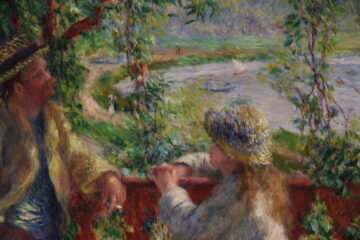Harmon Siegel at Artforum:
 IF ITS POTENTIAL BEAUTY is one reason that my MAGA friend can appreciate Impressionism but not its avant-garde successors, another is the movement’s ambiguity between upholding and condemning the forms of authority that dominate modern society. On the one hand, we have the glassy stares of Morisot’s caregivers, the sickly pallor of Degas’s absinthe fiends, and the insectoid inhabitants of Pissarro’s anomic streetscapes––these seem to protest the quotidian cruelties of bourgeois existence, critiquing, respectively, patriarchal subjugation, social disintegration, and bureaucratic administration. On the other, we have Caillebotte’s weekend boaters, Cassatt’s loving families, and Renoir’s dancing couples––these seem to salute the little pleasures of modern life, affirming, respectively, suburban leisure, domestic femininity, and erotic gaiety. These oppositions occur not only between paintings, but even within individual works.
IF ITS POTENTIAL BEAUTY is one reason that my MAGA friend can appreciate Impressionism but not its avant-garde successors, another is the movement’s ambiguity between upholding and condemning the forms of authority that dominate modern society. On the one hand, we have the glassy stares of Morisot’s caregivers, the sickly pallor of Degas’s absinthe fiends, and the insectoid inhabitants of Pissarro’s anomic streetscapes––these seem to protest the quotidian cruelties of bourgeois existence, critiquing, respectively, patriarchal subjugation, social disintegration, and bureaucratic administration. On the other, we have Caillebotte’s weekend boaters, Cassatt’s loving families, and Renoir’s dancing couples––these seem to salute the little pleasures of modern life, affirming, respectively, suburban leisure, domestic femininity, and erotic gaiety. These oppositions occur not only between paintings, but even within individual works.
Take Caillebotte’s Le Pont de l’Europe, 1876. In Herbert’s book, the art historian writes that the painter adopted his exaggerated perspective to amplify the “cyclopean metalwork” of the iron bridge as an “embodiment of industrial power [and an] aggressive symbol of the transformation of Paris.”
more here.
